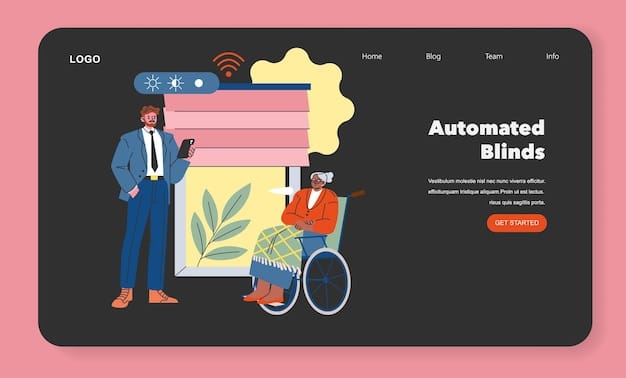Disability Rights in the Workplace: Employer Guide 2025

In 2025, employers must understand and comply with disability rights laws like the ADA, ensuring equal opportunities through reasonable accommodations, accessible technology, and inclusive hiring practices to foster a diverse and equitable work environment.
Navigating disability rights in the workplace: what employers need to know in 2025 is crucial for creating an inclusive and compliant work environment. Are you prepared to meet the evolving standards and ensure equal opportunity for all employees? This guide will provide essential insights and practical steps for employers in the U.S.
Understanding the Americans with Disabilities Act (ADA) in 2025
The Americans with Disabilities Act (ADA) remains the cornerstone of disability rights in the U.S. Understanding its key provisions is essential for employers. Let’s delve into what this means for your workplace in 2025.
Key Provisions of the ADA
The ADA prohibits discrimination against individuals with disabilities in employment, public services, and accommodations. This means employers must provide equal opportunities.
Who is Protected Under the ADA?
The ADA protects individuals with physical or mental impairments that substantially limit one or more major life activities. This includes a wide range of conditions.
- Ensure job descriptions accurately reflect essential functions.
- Provide reasonable accommodations to qualified individuals.
- Maintain confidentiality of employee medical information.
- Prevent harassment or discrimination based on disability.
Staying informed about the ADA’s nuances is vital. It ensures your company not only complies with the law, but also fosters a more inclusive culture. By understanding these provisions, employers can create a workplace where everyone has the opportunity to succeed.

Reasonable Accommodations: What Employers Need to Provide
Providing reasonable accommodations is a key responsibility for employers. It ensures that employees with disabilities can perform their job effectively. Here’s how to navigate this process.
Examples of Reasonable Accommodations
Reasonable accommodations can include adjusting work schedules, modifying equipment, or providing assistive technologies. It’s about tailoring the workplace to individual needs.
How to Determine if an Accommodation is Reasonable
Determining reasonableness involves assessing whether the accommodation would cause undue hardship to the employer. Balance the employee’s needs with the operational requirements.
- Engage in an interactive process with the employee.
- Document all discussions and considerations.
- Explore various accommodation options.
- Consult with disability organizations if needed.
Implementing reasonable accommodations demonstrates a commitment to inclusivity. It’s about creating an environment where employees with disabilities can thrive and contribute their best work.
Creating an Accessible Workplace: Beyond Compliance
Creating an accessible workplace goes beyond simply meeting legal requirements. It involves designing an environment that is inclusive and user-friendly for everyone. Let’s explore how to achieve this.
Physical Accessibility
Physical accessibility includes ensuring that the workplace is easily navigable for individuals with mobility impairments. This involves ramps, elevators, and accessible restrooms.
Digital Accessibility
Digital accessibility focuses on making websites, software, and other digital tools usable for people with disabilities. This includes providing alternative text for images and captions for videos.

- Conduct regular accessibility audits.
- Provide training on accessible design principles.
- Involve people with disabilities in testing and feedback.
- Use accessible templates and tools.
Building an accessible workplace fosters a sense of belonging. It’s about creating a space where everyone feels welcome, valued, and empowered to participate fully.
Inclusive Hiring Practices: Attracting Diverse Talent
Embracing inclusive hiring practices is essential for attracting a diverse pool of talent. It’s about creating opportunities for people with disabilities to join and contribute to your organization. Here’s how to implement inclusive strategies.
Writing Inclusive Job Descriptions
Use clear and concise language in job descriptions, focusing on essential functions. Avoid jargon or language that may deter qualified candidates with disabilities.
Reaching Out to Disability Organizations
Partner with disability organizations to expand your recruitment network. These organizations can help you connect with qualified candidates and provide support throughout the hiring process.
- Offer internships and apprenticeships for people with disabilities.
- Provide accommodations during the interview process.
- Train hiring managers on disability awareness and inclusion.
- Highlight your commitment to diversity and inclusion in recruitment materials.
Inclusive hiring practices strengthen your organization. It’s about tapping into a wider range of skills, perspectives, and experiences, which ultimately drives innovation and success.
Training and Awareness: Building a Culture of Inclusion
Training and awareness programs play a crucial role in building a culture of inclusion. Educating employees about disability rights and etiquette fosters a more welcoming and respectful workplace. Let’s explore how to implement effective training initiatives.
Disability Awareness Training
Disability awareness training helps employees understand different types of disabilities and how to interact respectfully with colleagues who have disabilities. Cover topics such as communication etiquette and common misconceptions.
Understanding Your Legal Obligations
Provide training on the legal obligations under the ADA and other relevant laws. Ensure employees understand their responsibilities in creating an inclusive workplace.
- Incorporate disability inclusion into onboarding programs.
- Offer ongoing training and refreshers.
- Invite people with disabilities to share their experiences.
- Create a culture of open communication and feedback.
Investing in training and awareness initiatives cultivates a culture of empathy and understanding. It’s about empowering employees to embrace diversity and contribute to a more inclusive workplace.
Leveraging Technology for Disability Inclusion
Technology plays a significant role in promoting disability inclusion. Assistive technologies and accessible digital tools enable people with disabilities to participate fully in the workplace. Let’s explore how to leverage technology effectively.
Assistive Technologies
Explore assistive technologies such as screen readers, voice recognition software, and adaptive keyboards. These tools can help employees overcome barriers and perform their job effectively.
Accessible Digital Tools
Ensure that your digital tools and platforms are accessible to people with disabilities. This includes websites, software applications, and online training materials.
- Partner with technology vendors to ensure accessibility.
- Provide training on using assistive technologies.
- Involve people with disabilities in testing digital tools.
- Stay up-to-date with the latest accessibility standards.
Utilizing technology for disability inclusion removes barriers. It’s about creating a level playing field and empowering employees with disabilities to succeed in the digital age.
| Key Aspect | Brief Description |
|---|---|
| ♿ ADA Compliance | Understanding and adhering to the Americans with Disabilities Act. |
| 🏢 Workplace Accessibility | Creating a physically and digitally accessible environment. |
| 🤝 Inclusive Hiring | Implementing strategies to attract and hire diverse talent. |
| 📚 Training & Awareness | Educating employees on disability rights and etiquette. |
Frequently Asked Questions
The ADA prohibits discrimination based on disability. It requires employers to provide reasonable accommodations and ensure equal opportunities in employment, affecting all aspects of your business operations and culture.
Reasonable accommodations are adjustments to work tasks or environments enabling disabled employees to perform their jobs, like modified equipment or schedules. Engage in an interactive process with the employee to identify suitable accommodations.
Enhance accessibility through accommodations like ramps, elevators, and accessible restrooms. Ensure digital tools and websites are accessible with features like screen reader compatibility and alternative text for images.
Inclusive hiring practices involve creating non-discriminatory job descriptions and reaching out to disability organizations. Also, providing accommodations during interviews and training hiring managers on disability awareness are essential.
Employee training enhances understanding and respect towards colleagues with disabilities, helping reduce bias and promoting a more inclusive work environment where all contributions are valued.
Conclusion
Staying informed about disability rights in the workplace is not just a legal obligation but a commitment to equality and inclusion. By understanding the ADA, providing reasonable accommodations, creating an accessible work environment, and implementing inclusive hiring practices, employers can foster a workplace where everyone has the opportunity to thrive.





